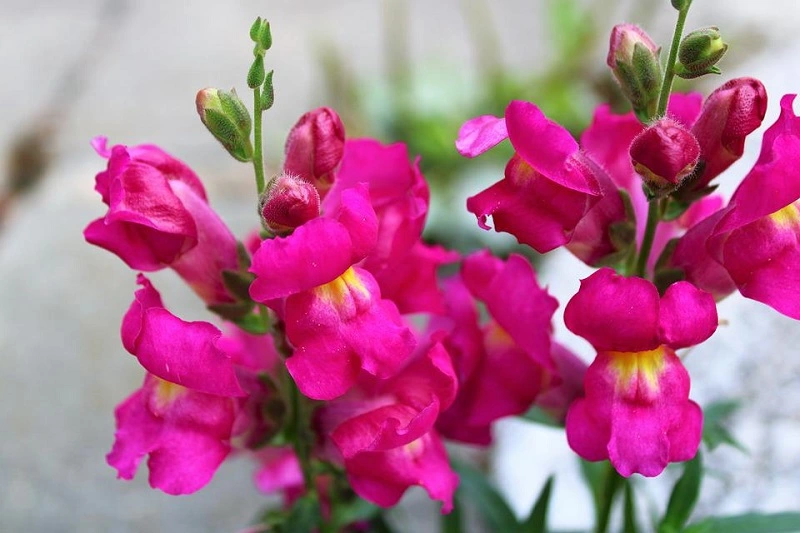Soin des Mufliers - Période de Floraison, Besoins, Arrosage
Le muflier est l'une des plantes qui étonnent par leurs fleurs étonnantes et rendent le jardin plus coloré. Ses semis sont largement disponibles et peuvent être achetés dans pratiquement tous les magasins de fleurs. En raison de son apparence et de ses propriétés décoratives, cette plante apparaît couramment dans les jardins, quelle que soit leur taille. Les fleurs de muflier ne sont pas difficiles à entretenir, de sorte que même un jardinier débutant devrait être en mesure de les cultiver.

Muflier - origines et caractéristiques de la plante
La mufle, ou Antirrhinum majus est une plante également connue sous le nom de fleur de dragon ou fleur de chien. La plante est une annuelle de la famille des plantains. En raison de leur aspect caractéristique et de leurs faibles exigences, les mufliers sont devenus un élément décoratif populaire dans de nombreux aménagements paysagers. Selon la variété, ils peuvent pousser dans des plates-bandes basses, ainsi qu’à côté de grands arbustes ornementaux.
La mufle peut atteindre différentes hauteurs, en fonction de la variété. En moyenne, la plante mesure environ 70 cm (2,3 ft) de haut, mais certains types sont soit beaucoup plus grands, soit plus courts.

Muflier - les variétés les plus populaires
Le muflier est une plante aux multiples variétés. L’espèce se divise en deux catégories : les plantes qui ont besoin de protection et qui sont donc cultivées en conteneurs, et les plus rustiques qui peuvent être plantées dans différents types de sol. Les variétés de mufliers les plus populaires sont:
- Antirrhinum majus ‘Ruby’ - elle produit des fleurs rouge foncé, la plante elle-même est buissonnante, de densité moyenne,
- Muflier ‘Samouraï’ - il produit des fleurs roses, la plante est buissonnante et dense.
- Muflier nain - c’est une variété à faible croissance avec différentes couleurs de fleurs, du blanc au rouge, jaune, rose et orange.

Quels sont les besoins des mufliers ?
Les mufliers sont souvent choisis par les jardiniers débutants, principalement parce qu’ils sont faciles à cultiver et à entretenir. C’est une plante qui a peu de besoins, grâce à quoi sa culture se fait presque sans effort. Notez que les mufliers préfèrent les sols de très bonne perméabilité. Un sol sableux et riche en humus est la meilleure option. Le sol ne doit pas être trop sec, il est bon de le garder modérément humide. Le muflier peut cependant supporter un sol modérément sec. Lorsque vous choisissez un endroit pour la plantation, pensez à un ensoleillement suffisant. Le muflier aime pousser en plein soleil.
Si vous optez pour cette plante, n’oubliez pas qu’il n’est pas nécessaire de la planter directement dans les parterres de fleurs. Les mufliers peuvent également pousser dans des conteneurs qui peuvent être placés à l’intérieur de janvier à avril. Grâce à cela, vous pouvez les utiliser pour décorer un patio ou un balcon.
Nous vous recommandons de suivre les règles générales d’entretien des plantes. Enlevez régulièrement les mauvaises herbes autour des mufliers. Les fleurs qui ont fini de fleurir doivent être décapitées - cela renforce la plante mufle et assure une floraison plus longue.

Le muflier a-t-il besoin d’un arrosage fréquent ?
Les mufliers ont besoin d’un arrosage fréquent et régulier, surtout en période de floraison. La plante n’aime pas la sécheresse, mais le sol ne doit pas être excessivement humide non plus, car l’eau stagnante peut être nuisible et entraîner la pourriture des racines.
Muflier - faut-il fertiliser la plante ?
Si vous optez pour cette plante, vous devez également penser à la fertilisation. Les produits à ingrédients multiples conçus pour les plantes à fleurs sont la meilleure option, car ils fournissent tous les éléments nutritifs nécessaires à la floraison Ces produits nutritionnels pour plantes peuvent être achetés dans n’importe quel magasin de fleurs. Ils se présentent sous différentes formes, telles que :
- poudres solubles dans l’eau,
- liquides,
- bâtons.

Muflier - propagation
Les mufliers peuvent être propagés de deux façons. **La plus courante consiste à récolter et à semer les graines de la plante. Si vous prévoyez de les récolter sur la plante, il faut laisser les fleurs sécher après la floraison et recueillir les gousses de graines. Vous pouvez les conserver jusqu’au printemps, puis les planter.
L’autre méthode consiste à diviser la plante. Elle peut être réalisée avec succès avec des plantes complètement matures. Déterrez délicatement la plante, puis divisez-la. Replantez les nouvelles fleurs dans le sol, en veillant à ce qu’elles soient à la même profondeur que précédemment.
Muflier - ravageurs et maladies
Les mufliers peuvent être attaqués par des agents pathogènes. La rouille du muflier est le danger le plus courant. La plante affectée développe des taches brunes sur ses feuilles. Des produits antifongiques peuvent aider à combattre ce problème. Les feuilles attaquées doivent être enlevées, ainsi que celles qui sont mortes et tombées.
Un sol inadéquat ou un arrosage trop intense est un autre danger pour les mufliers. Un sol imperméable et une humidité prolongée peuvent faire pourrir la plante. Si cela se produit, il est difficile de sauver la plante.
Les pucerons sont les ravageurs les plus courants qui attaquent les mufliers. Heureusement, il est facile de s’en débarrasser. Il suffit d’utiliser des remèdes antiparasitaires adéquats. Même ceux achetés dans les magasins de jardinage sont aujourd’hui très sûrs pour les plantes. Certains produits sont respectueux de l’environnement, et ils sont vivement recommandés par les experts en raison de la qualité de leurs ingrédients.

📍 À quoi ressemble une fleur de muflier ?
Le muflier est une plante annuelle. Elle a un port buissonnant et des feuilles lancéolées. Elle peut atteindre une hauteur de 90 cm (3 ft). Les fleurs montantes sont le trait caractéristique de cette plante.
📍 Quand planter les mufliers ?
Les mufliers peuvent être plantés directement en terre. Il faut le faire entre avril et mai. Les graines ainsi plantées fleuriront en août. Le temps habituel entre le semis et la floraison est de 10 à 12 semaines.
📍 Comment planter des mufliers ?
Les mufliers peuvent être plantés sous forme de plants achetés ou de graines semées. Si vous optez pour les graines, plantez-les entre avril et mai. Semez-les à la surface du sol et appuyez légèrement dessus. Laissez un peu d'espace entre les plants, de 15 à 40 cm, selon la variété.
📍 Quand les mufliers fleurissent-ils ?
Les mufliers ont besoin de 10 à 12 semaines pour fleurir s'ils sont plantés à partir de graines. S'ils sont semés à la période recommandée, la plante devrait fleurir de fin juin à fin août. Vous pouvez également planter les graines plus tôt dans des conteneurs - de cette façon, vous pouvez vous attendre à ce que les mufliers fleurissent plus tôt.
Articles de fond




